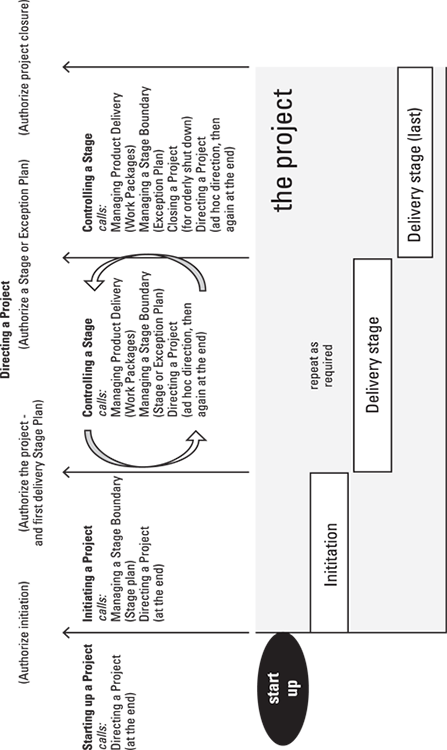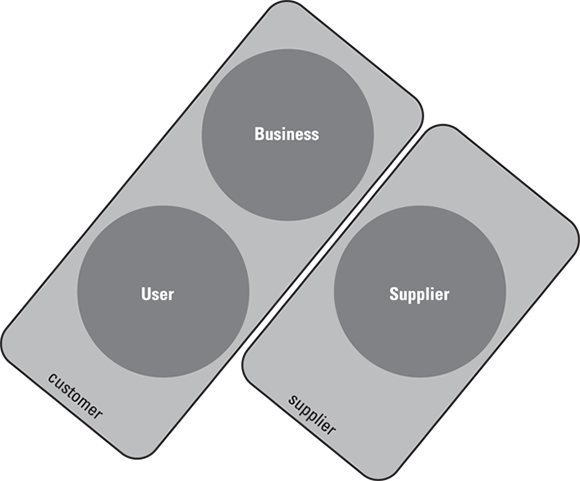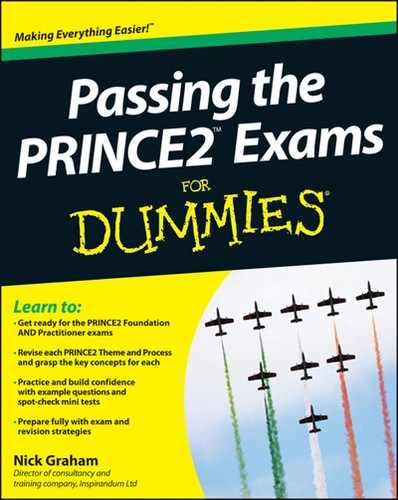Appreciating the Four Integrated Elements
PRINCE2 talks of four integrated elements. These are simply the:
![]() Processes
Processes
![]() Themes
Themes
![]() Principles
Principles
![]() Tailoring PRINCE2 to the project environment
Tailoring PRINCE2 to the project environment
When you fully understand the method, you’ll see how the four fit together. It’s actually rather important that you do see how the elements fit together, because you’re expected to know that for both exams. For the Foundation exam especially, be sure also to take on board the phrase ‘four integrated elements’.
The Processes
The processes are the suggested ‘when’ you do something. They cover the sequence of the project from Start Up to closure. In anything other than a small project, you’re likely to have several delivery stages, so the processes used for the delivery stages will repeat for as many stages as there are. A variation occurs in the last stage, however, since at the end of it you’ll be closing the project rather than preparing for a following stage.
It’s a common mistake to think that each stage in the project involves a single process. While it’s true that each stage is driven by a single process, that process will ‘call’ other processes to do parts of the work. Figure 19-1 shows Start Up and the project stages and illustrates where the processes are involved.
You’ll have seen from the PRINCE2 manual that every process has a process diagram. In each case, the diagram shows a series of activities for the process, with those activities linked by arrows to show the default sequence in which you do them. In the Practitioner exam, the exact activities and sequences are not going to present a problem because the exam is open book and you can have the manual open in front of you to look at the diagrams whenever you want to. For the Foundation exam, which is closed book, you need to be aware of the activities in each process to know what that process is doing, and of the overall sequence in which the manual suggests that the activities are done. You do not, however, need to learn the diagrams by heart.
Going down a level, the method then has recommended actions within each activity. The recommended actions are listed as bullet points under each activity heading in the PRINCE2 manual. Unless you have a photographic memory, you’ll never remember all the actions for all the activities in the method, but you do need to be aware of what the activity is about and particularly who’s doing it and which management products (such as the Business Case, the Daily Log and the Project Plan) are in use.
There are seven processes, and for the Foundation exam you should be able to list them from memory.

Figure 19-1: The PRINCE2 processes in relation to Start Up and the project stages.
The Themes
In contrast to the processes, which give the suggested ‘when’ (the points at which you do things), the themes set down advice on ‘what’ you do in project management – or at least in the parts of project management that the method covers, which isn’t all of it. So the themes cover things like planning, risk management and progress control.
In some parts of the method you’ll use particular themes intensively, while in other parts you’ll hardly use those themes at all. Other themes are pretty much in continuous use throughout. Progress control will obviously be happening right through the stages, while the Organization theme will be used mostly in Start Up, with a bit in Initiation and at the end of each stage to adjust the roles and responsibilities if that proves necessary.
PRINCE2 has seven themes, and for the Foundation exam you should be able to remember what they are.
The Principles
The principles are, allegedly, what makes a project a PRINCE2 project. The authors of the manual have very bravely said that unless a project is following all seven principles, then it isn’t a PRINCE2 project. That means there are considerably fewer PRINCE2 projects out there than everyone thinks. So, PRINCE2 expects the project to be fully justified throughout, and this is set down in the first principle, that of ‘continued business justification’.
If you’re reading this chapter as you’re starting to learn PRINCE2, don’t worry too much about the principles at the beginning. They’ll make more sense as you go through the method; then you can check to ensure that you understand each one at the end. For example, the principle ‘manage by exception’ isn’t going to make complete sense until you see how the stages work. When you’ve learned all the themes and processes, you should be fully aware of exactly what each principle is, so check this out to make sure.
For the Foundation exam, you need to know the list of seven principles, and for both exams you need to be really clear on what each one is about.
Tailoring to the project environment
It may seem a bit strange to include the project environment in the ‘integrated elements’ since it isn’t something with distinct PRINCE2 content, unlike the other three elements. Rather, it’s more like a backdrop behind the other three elements. PRINCE2 states clearly (at long last) that the method must be fitted to the needs of the project.
Because the project environment and tailoring doesn’t have content you have to learn, it’s easy to forget that it’s one of the four elements, so watch out for that when revising for the Foundation exam. You may find that you can reel off the first three elements from memory easily enough, but then struggle to remember what the fourth one is.
There are three important viewpoints in PRINCE2: business, user and supplier (BUS). The viewpoints fit into the customer/supplier environment, with the business and user interests on the customer side, and the supplier, predictably, on the supplier side. Figure 19-2 illustrates the fit of the three views and may help you remember them.

Figure 19-2: The three viewpoints and the customer/supplier environment.
 Perusing purpose statements
Perusing purpose statements
All the processes and themes have a purpose statement. Unfortunately, these purpose statements are the subject of some questions in the Foundation exam question pool. Knowing the method and how the parts fit together includes knowing the purpose of each part, so you need to be able to recognise which purpose statements go with each theme and process. So, once you’ve looked at all the themes and processes, do you think you can recognise the purpose statements? For each statement in the quiz, say which theme or process it belongs to:
1. To establish mechanisms to judge whether the project is (and remains) desirable, viable and achievable
2. To enable the Project Board to be accountable for the project’s success by making key decisions and exercising overall control
3. To assign work to be done
4. To identify, assess and control uncertainty
5. To establish mechanisms to monitor and compare actual achievements against those planned
You’ll find the answers at the end of the chapter. One of the tricks here is to identify key words that associate the purpose statement with a particular theme or process; the answers give examples of that too.
Understanding How It All Fits Together
Having learned the various bits of PRINCE2, it can be hard to see how they fit together. The introduction to this chapter may have helped by explaining that the processes are the ‘when’ and the themes are the ‘what’ you do. However, for the exams, you’re going to need to take that forward to specific knowledge.
How the themes fit with the processes
Knowing where the themes fit into the process is both intuitive and, when you know the themes, sort of obvious. However, the fit is also complicated. My son Peter, to whom this book is dedicated, has always been great with graphics, and when he worked for my company for a while he built a bit of software that gave an overview of PRINCE2. Part of it was a picture of the high level process model alongside the ‘pie chart’ of the themes. It was ingenious. When you selected a process, the themes that are used by that process lit up. When you selected a theme, the processes that use it lit up. The trouble was that nobody was ever going to remember those combinations, and sadly we ended up dropping that part of the software. It’s that same complex matching that you’re facing right now.
You may find it helpful as part of your revision to write two lists to mimic Peter’s software model. Write down a list of the seven processes. For each one, then think through what’s going on and list the themes that are involved. For example, in the process of Starting Up a Project, the first activity is ‘Appoint the Executive and the Project Manager’. The work involves roles and responsibilities then, so write down ‘Organization’ in your list of themes used by the Start Up process.
When you’ve finished with the processes, write another list, this time of the seven themes. For each theme, look at the process model again and think which processes use that theme. So, when working on the Organization theme, you’ll write down ‘Starting Up a Project’. The Organization theme is used by Start Up in its first activity of ‘Appoint the Executive and Project Manager’, as noted in the previous paragraph, but then again for the activity ‘Design and appoint the project management team’.
Tracking the principles through the method
The PRINCE2 examiners are quite keen on putting in questions to test your knowledge of how the processes and themes ‘support’ the principles. You can take the same approach to revising the support of the principles as with the interaction of themes and processes – by writing lists. Don’t try to memorise the lists, or your brain will be in grave danger of exploding, but rather use the list as a means of recording your understanding of the interaction as you revise. It’s that understanding which will then lead you to the correct answers in the exams.
Understanding how the PRINCE2 principles are supported by the rest of the method involves you in some careful thinking, so here’s an example to show what your list might look like as you start to consider the principle of ‘learn from experience’.
Learn from experience:
![]() Starting Up a Project: Lessons Log created. Lessons from the past that need to be considered for this project entered into the log.
Starting Up a Project: Lessons Log created. Lessons from the past that need to be considered for this project entered into the log.
![]() Directing a Project: Passing on lessons learned in this project, as reported by the Project Manager, into the organisation. Making sure that plans and the Project Initiation Documentation (PID) for this project take on board lessons from the past.
Directing a Project: Passing on lessons learned in this project, as reported by the Project Manager, into the organisation. Making sure that plans and the Project Initiation Documentation (PID) for this project take on board lessons from the past.
![]() Initiating a Project: Applying past lessons from the log when preparing the PID. Noting any new lessons learned during Initiation into the Lessons Log.
Initiating a Project: Applying past lessons from the log when preparing the PID. Noting any new lessons learned during Initiation into the Lessons Log.
![]() Controlling a Stage: Looking for lessons, logging them and putting them in Highlight Reports. Logging lessons being learned when dealing with issues and risks. Taking note of lessons information recorded by Team Managers in their Checkpoint Reports.
Controlling a Stage: Looking for lessons, logging them and putting them in Highlight Reports. Logging lessons being learned when dealing with issues and risks. Taking note of lessons information recorded by Team Managers in their Checkpoint Reports.
![]() Managing Product Delivery: Team Managers looking for lessons and putting them on Checkpoint Reports.
Managing Product Delivery: Team Managers looking for lessons and putting them on Checkpoint Reports.
![]() Managing a Stage Boundary: Lessons Report included in the End Stage Report.
Managing a Stage Boundary: Lessons Report included in the End Stage Report.
![]() Closing a Project: Lessons Report, from Lessons Log entries, included in the End Project Report. Also some lessons may lead to follow-on action recommendations to be passed back into the organisation, for example recommending a change in project standards because of something learned. Lessons Log closed.
Closing a Project: Lessons Report, from Lessons Log entries, included in the End Project Report. Also some lessons may lead to follow-on action recommendations to be passed back into the organisation, for example recommending a change in project standards because of something learned. Lessons Log closed.
